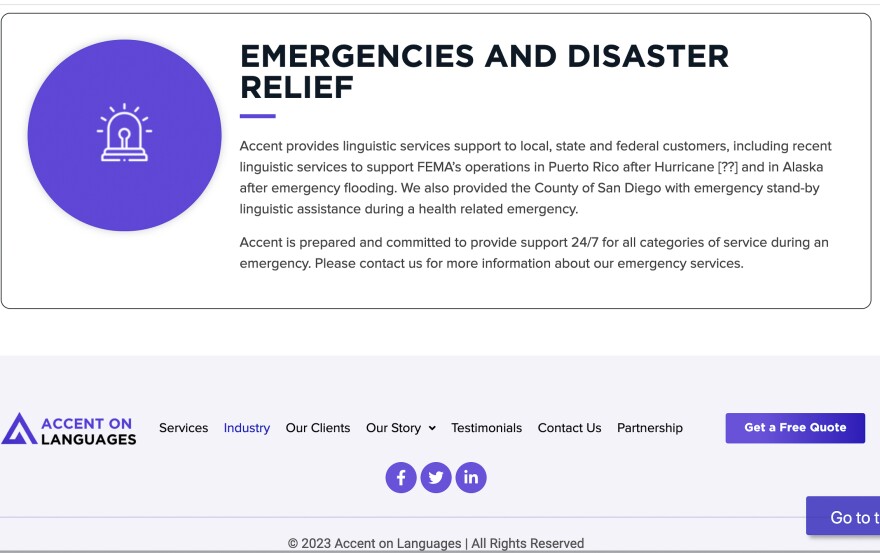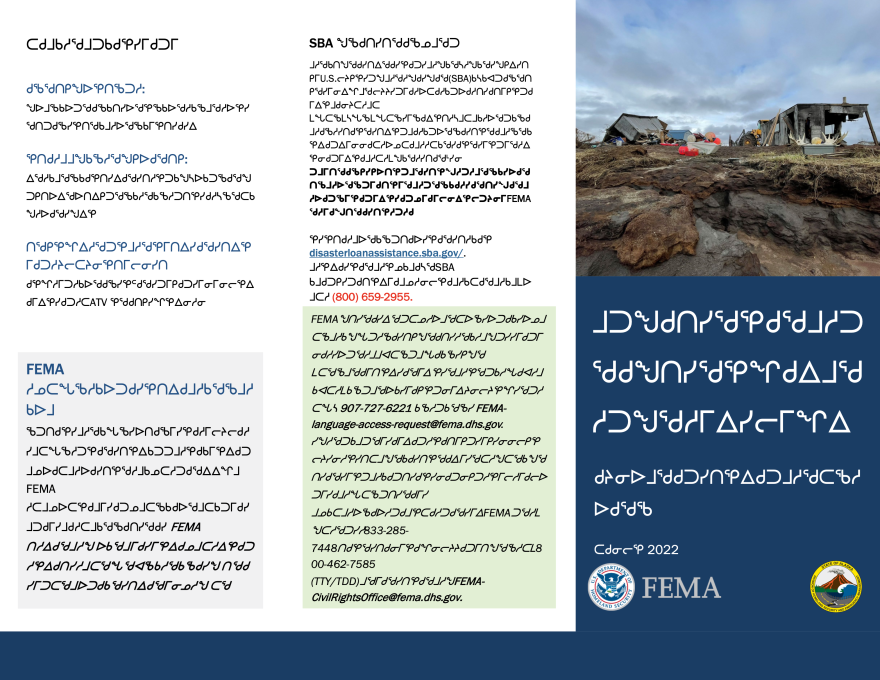After Typhoon Merbok slammed into Alaska’s west coast in September 2022, the Federal Emergency Management Agency (FEMA) hired a California-based company to translate information into two Alaska Native languages about how to apply for disaster recovery assistance. Typhoon Merbok damaged homes and destroyed subsistence fishing and hunting tools and camps all over the Y-K Delta and on the Seward Peninsula.
The translated documents were supposed to offer information on how to apply for financial assistance. On the Y-K Delta, at least half the population, about 10,000 people, learn Yugtun, or the Central Yup’ik dialect, before they learn English. Another 3,000 people speak Iñupiaq further north.
Julia Jimmie, a translator at KYUK, said that the Yugtun translations were incorrect. Other Indigenous language speakers also didn’t understand the translated documents. Two sources on Nelson Island agreed: they were not Central Yup’ik. Another source from Chevak said that it wasn’t Cup’ik. Siberian Yup’ik speakers also couldn’t make sense of the documents.
Tara Sweeney, the former Assistant Secretary of Indian Affairs under the Trump Administration, also said that the Iñupiaq translations were wrong; her great-grandfather helped develop the Iñupiaq alphabet.
“We don’t use characters like the letter ‘e’, or the way some of the words seem to be put together or structured,” Sweeney said.
Imagine if someone, you know, took all of your folktales and then interviewed your great-grandmother about her experiences growing up. And had all of this information recorded, and wrote it down, and then scrambled it and stuck it in various different ways and made kind of a collage out of it. It's offensive.Gary Holton, linguist
To refer to the documents as translations would be wrong, said linguist Gary Holton.
“That is an amazing understatement,” Holton said after reviewing some of the documents. “The only thing you might gather from that is there are a couple of dates, but you wouldn't know what those dates are for. I would say the only useful bit of information in there might be if there's a reference to a website or something.”
Holton spent 20 years documenting Alaska Native languages at the University of Alaska Fairbanks’ Alaska Native Language Center. He said that whoever created the Yup’ik translations just lifted full phrases from a compilation of language and folklore from Far East Russia known as the Rubtsova texts. It was published in the Soviet Union in the 1940s.
According to Holton, in at least one of the documents where FEMA’s news release says “State News Desk,” the translated version reads, "when she said so, the dog ran farther off from the curtain.” In another section of the same document, what should be a translation of information about the Small Business Administration reads, "that one said that I should draw a line on the ice when he gets close."
“I mean imagine if someone, you know, took all of your folktales and then interviewed your great-grandmother about her experiences growing up. And had all of this information recorded, and wrote it down, and then scrambled it and stuck it in various different ways and made kind of a collage out of it,” Holton said. “It's offensive.”
Sweeney agreed. She said that the work is not only a waste of federal funding, it’s insulting to Alaska’s Indigenous people.
“There’s a lot of that historical trauma of being beaten in schools because they were speaking their Indigenous languages, which is why there’s a generation of us in Alaska that struggle with fluency,” Sweeney said.

The company contracted to do the work is Accent on Languages, whose website boasts a 100% customer satisfaction rate and touts its recent service in Alaska “after emergency flooding.” CEO Caroline Lee declined to answer questions about how or why the mistakes happened and what she plans to do to ensure that something like this doesn’t happen again.
The company’s Iñupiaq translations were meant to help language speakers in the Bering Strait Region who were impacted by Typhoon Merbok. But at least one of Accent on Languages’ Iñupiaq translations was actually done in the Inuktitut alphabet. Inuktitut is an Indigenous language spoken in Northeastern Canada. The mistake should have been an easy catch because the Inuktitut alphabet is made up of syllabic characters, unlike Iñupiaq where many of the letters are identical to the Latin alphabet.

At least two Inuktitut speakers in Canada said that a tri-fold glossy brochure created for FEMA by Accent on Languages is unintelligible.
FEMA spokesperson Sharon Sanders said that some of the translations were up to two weeks late. Her colleague, Tom Kempton, said that he had suspicions about the inaccuracies from the beginning. He said that the final products looked strange.
“I don't speak, you know, Yup’ik. What we were seeing coming back, I mean, when I first saw the Iñupiat [sic] ones I was like, ‘What is this?' It was all, like, hieroglyphic,” Kempton said.
According to FEMA, the agency paid $27,800 for the translations. The money comes out of a larger contract Accent on Languages holds with the U.S. Department of Homeland Security. There are at least half a dozen news releases and other documents that have been translated incorrectly.
Services to American citizens are being denied, especially in time of need.Tara Sweeney, former Assistant Secretary of Indian Affairs
“It's a problem for underrepresented, minority communities if this is the type of information that's being disseminated and people can't even understand it,” Sweeney said. “Services to American citizens are being denied, especially in time of need. That is egregious.”
FEMA spokesperson Sharon Sanders said that the translations were not widely distributed, but they were sent to at least two radio stations and two newspapers in Western Alaska. And in October, a month after Typhoon Merbok hit the state, multiple staff members of Alaska’s Congressional delegation reported receiving the incorrect Iñupiaq translation at Alaska Federation of Natives (AFN), the largest annual gathering of Alaska Natives.
Staff from both Sen. Lisa Murkowski and Rep. Mary Peltola’s offices said that they informed the agency that the translations had many problems. In response, Sanders said that the mistranslated documents were removed from FEMA’s website. The agency also hired an Alaska-based company to continue the work.

language speakers impacted by the storm, but the company's produced "unintelligible" work, according to speakers of both languages.
In a December statement, FEMA said that it was “committed to enhancing [it’s] capacity to work with Tribal Nations … which includes providing culturally competent services and translating FEMA products into Native American languages… ” But whoever wrote that statement later misspelled both Yup’ik and Iñupiaq.
“All I can say is, you know, FEMA is a people-first agency,” Sanders said. “We're people helping people who have been hurt, right? So when we don't get it right, that really matters to us. And we work really hard then to make sure we do get it right.”
To date, the agency has paid roughly $7,600 per applicant to people whose applications for disaster relief were approved. To put that into perspective, the agency paid the original translation service, Accent on Languages, more than three times that amount, which is also more than the median annual income in the Yukon-Kuskokwim region.



